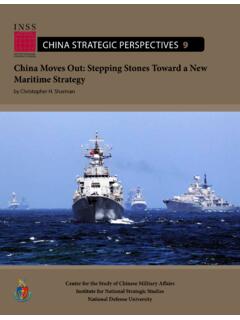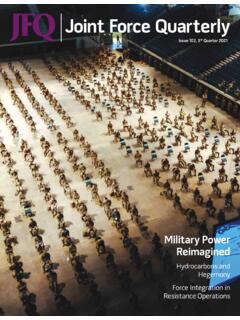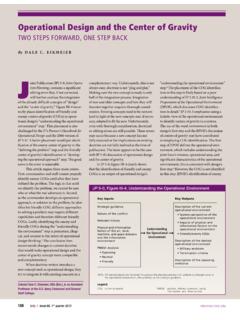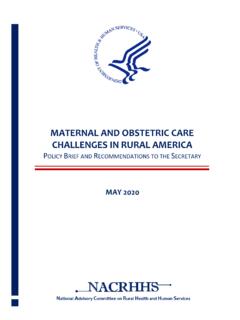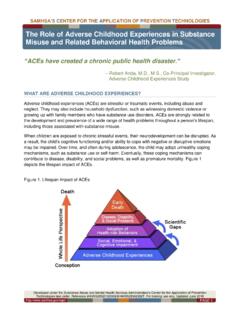Transcription of A Strategic Leader’s Guide to Transforming
1 60 JPME Today / Transforming Culture in Large Organizations JFQ 86, 3rd Quarter 2017A Strategic Leader s Guide to Transforming Culture in Large OrganizationsBy Mark Schmidt and Ryan SlaughterAs the Department of Defense (DOD) transitions to a new administration, it will be accompanied by numerous editorials advocating for equipment moderniza-tion and changing our theater-specific postures. Many of these discussions will call for altering DOD s current strategy. In essence, they will reiterate a dogmatic logic among the depart-ment s leadership: the best way to solve a problem is to develop a new strategy.
2 To succeed, we must realize that focus-ing mainly on strategy will cause us to overlook our greatest advantage organizational Lencioni relates the impor-tance of organizational health (culture) this way: The single greatest advantage any company can achieve is organization health. Yet it is ignored by most leaders even though it is simple, free, and avail-able to anyone who wants it. 1 Prior to Lieutenant Colonel Mark Schmidt, USAF, is a student at the National War College. Major Ryan Slaughter, USAF, is the Director of Operations at the 44th Reconnaissance Squadron, Creech Air Force Base, Admiral Thomas Rowden, commander, Naval Surface Forces, Pacific Fleet, speaks to Sailors assigned to Arleigh Burke class guided-missile destroyer USS Shoup during his visit to Naval Station Everett, November 1, 2016 ( Navy/Joseph Montemarano)
3 JFQ 86, 3rd Quarter 2017 Schmidt and Slaughter 61overhauls of our current strategy, the new administration should ask DOD strate-gic leaders the Secretary of Defense, Chairman of the Joint Chiefs of Staff, Service chiefs, and combatant and compo-nent commanders to focus on creating or fostering a healthy culture. These top-tier military leaders are uniquely re-sponsible and positioned to forge a culture that will increase engagement, innovation, and empowerment, yielding a military that promotes and retains its best practices and warfighters. This article presents a brief overview of organizational culture followed by a three-part construct that enables Strategic leaders to assess, bench-mark, and positively transform DOD culture.
4 As part of the leadership transi-tion, incoming Strategic leaders should first assess the culture of the entire orga-nization and benchmark the assessment across the DOD and against private sec-tors. Once DOD culture is benchmarked, an informed plan based on the findings should be implemented to promote and retain the most talented CultureThree decades ago, Edgar Schein introduced us to embedding mecha-nisms, which serve as the conscious and subconscious ways of forming organizational culture. Schein defines organizational culture as a pattern of shared basic assumptions that the group learned as it solved its problems of external adaption and internal integra-tion, which has worked well enough to be considered valid and, therefore, to be taught to new members as the correct way to perceive, think, and feel in relation to those problems.
5 2 He identifies six primary and six secondary embedding mechanisms as a way leaders measure success, react to crises, teach their values, reward performance, and preserve talent within their These mechanisms are used by Strategic leaders to instill their convic-tions and form a shared belief system by substituting continuous organizational oversight with guidance on how to perceive, think, feel, and At the tactical level, a leader can develop and manage culture through charisma and personal Because of the size of DOD, Strategic leaders rely mostly on embedding mechanisms, which serve as more formal and pro-cedural mechanisms that support and reinforce the primary It is important for leaders to understand which embedding mechanisms are in place that foster or impede positive culture change.
6 When embedding mechanisms misalign with a leader s vision, culture suffers because subor-dinates are confused by what the boss values. We focus on 3 of Schein s 12 embedding mechanisms, 2 primary and 1 secondary, to show where poten-tial exists to transform culture in the Defense Department. The three-step process is as follows: assess and benchmark organizational culture embrace feedback transform the and Benchmark Organizational CultureEmbedding Mechanism 1: What leaders pay attention to, measure, and control on a regular If you ask a combatant commander or Service chief the location of organizational assets and their readi-ness, the leader could quickly generate plenty of readiness statistics, asset facts, and preparedness measurements.
7 This collection of highly valuable metrics is critical in making informed decisions, and no Strategic leader would commit to action without them. However, it is our assessment that if we ask the same leaders , How s your culture? you will likely get less precise responses. Interest-ingly, readiness and some of the biggest challenges in DOD are culture-based (for example, sexual assault, suicide, and retention). It is likely that Strategic leaders are less prepared to assess organi-zational culture because it is considered not essential for organizational effective-ness or too hard to , DOD has no standardized metric that benchmarks all the Service cultures.
8 While working at Gallup, Marcus Buckingham and Curt Coffman introduced a short survey that measures culture in their book, First, Break All the Rules: What the World s Greatest Managers Do Differently. Gallup has studied and measured human behavior and organizational culture for over 80 years. After decades of employee surveys that included 100 to 200 ques-tions, broad audiences, and little effect, they identified five tenets necessary for an effective survey instrument. When measuring the strength of an organiza-tion s culture, surveys must be focused, measure what s important, be compa-rable, reinforce local accountability, and emphasize the process rather than specific events.
9 From Gallup s study emerged the Q12 survey of employee engagement. The Q12 has been administered to millions of employees representing thousands of organizations and demonstrates how measuring engagement is a key factor in high performing teams. The survey asks employees to assess their workplace expe-rience by scoring their level of agreement with 12 statements (see table), typically on a five-point Likert scale ranging from strongly disagree to strongly agree. 8 The responses are scored individually and as an should consider the Gallup Q12 as an ideal commercial off-the-shelf program and coordinate its administra-tion to all Services and civilian sectors in DOD.
10 The Q12 contains the core elements needed to attract, focus, and keep the most talented This cost-effective, proven, and brief metric will avoid survey fatigue experienced by today s warfighter, while offering a unique glimpse into organizational cul-ture. This new perspective will highlight where successes and failures can be ex-pected and turn the key to lasting cultural improvement. Once implemented, the Secretary of Defense could ask a Service chief or combatant commander, How s the culture in your organization? and expect a clear and standardized indicator of that organization s level of employee engagement and readiness.


